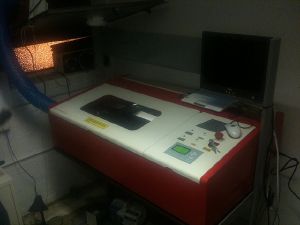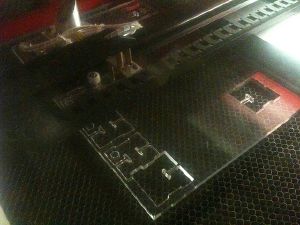Equipment/HPC LS3060 Laser Cutter
Jump to navigation
Jump to search
Logbook
15/09/2010 Operator Russ
- Cut some 1.5mm neoprene fairly successfully - needs high power and it's a bit smelly. (Settings in the book.)
- Circle issue is fixed. It was a problem with the tension on the frontmost X drive belt.
- Did some awesome etching onto black anodised aluminium - 450mm/sec, 90% power.
13/09/2010 Operator: samthetechie
Todo: Test CorelDraw X3 with 20mm circles on paper and compare to test using LaserCutter Software
12/09/2010 Operator: samthetechie
- Setup CorelDraw X3 with LaserCutter Add-on Toolbar.
- Cut Mic On Sign 3mm Perspex.
- Cut MusicMetric Sign 6mm MDF.
Model
- HPC LS3060 "plus" laser engraver and cutter.
Specification
| Laser: | 40W - water cooled CO2 laser. |
| Working area: | 320 x 600mm honeycomb bed (cutting area possibly about 300 x 550mm) |
| Features: | Air-assist (removes debris from cutting region),
red-dot pointer (to show beam location) |
| Water cooling: | Simple tube cooling circuit connected with (9mm OD, 6mm ID) latex tube.
Uses supplied submersible pond pump (2.8m head, 2800L/H flow). |
Safety information
Please don't touch or fiddle with the laser cutter unless you've had permission from either Russ or Jonty.
- Please don't affect the cooling system without consultation - overheating or rapid cooling can damage the laser.
- Never leave the laser cutter unattended - Your material may ignite, and an unchecked fire in the laser cutter could be both dangerous and costly.
- In case of fire - Use only the CO2 extinguisher positioned by the cutter.
- Never cut PVC or chlorinated plastic - You should always know what material you are cutting, and chlorinated plastics should be avoided because they release chlorine gas when cut.
- Do not try to cut metal in the laser cutter - If you wish to mark the metal, please use "Thermark Laser Engraving Spray / Paste", or use anodised aluminium.
Instructions
Powering on
TODO
- Insert key and turn
- Always perform the following pre-checks:
- Check that there is a CO2 fire extinguisher to hand.
- Check that the water pump is running
- Check that the extractor fan is on
- Caution: - Be certain that the water coolant is at a suitable temperature.
- If you are unsure if the cutter has been used recently, or have been using the cutter for an extended period of time (an hour or so) check the temperature of the water using the infra-red thermometer.
- If the water temperature is out side the acceptable operating range then wait for the water to cool before using the cutter,
Uploading your data file
TODO
- Different file types pros/cons
- Setting the scale
- Setting the origin - what to watch out for
- Layers - how are they used
- How do you know when the file is sent successfully
Positioning your material
TODO
- Caution: Know your material - be absolutely certain that your material is safe to use in the laser cutter. If in doubt - ask.
- Caution: There are a number of electrically live areas inside the cabinet towards the back. Be very careful when reaching around there as you may get a shock.
- Setting the bed Z-axis
- Viewing the bounding box with red-dot pointer
Cutting
TODO
- Caution - never leave the machine unattended
- Initiating the cut
- Monitoring progress
- What to watch out for
- What to do in case of problems
- What to try if the result is not what you expect
Parameters for different materials
If you found some sweet settings please share them here.
Cutting
| Material | Thickness (mm) | Speed (mm/sec) | Power (%) | Corner power (%) | Examples |
|---|---|---|---|---|---|
| Ply wood | 3 | ? | ? | ? | some images |
Engraving
| Material | Speed (mm/sec) | Power (%) | Corner power (%) | Examples |
|---|---|---|---|---|
| Anodized aluminium | 450 | 90 | ? | LHS logo on black phone |
Tips
- Some useful laser info from Adafruit - the settings section in particular gave a good idea of what we can expect.
- More information about the controller card used by the cutter
Consumables
- HPC sheet products - Laser ply, perspex, engraving laminate - where we purchased the cutter.
- The Plastics Shop - mattp purchased the plastic for the first batch of Hackspace key rings from here.

